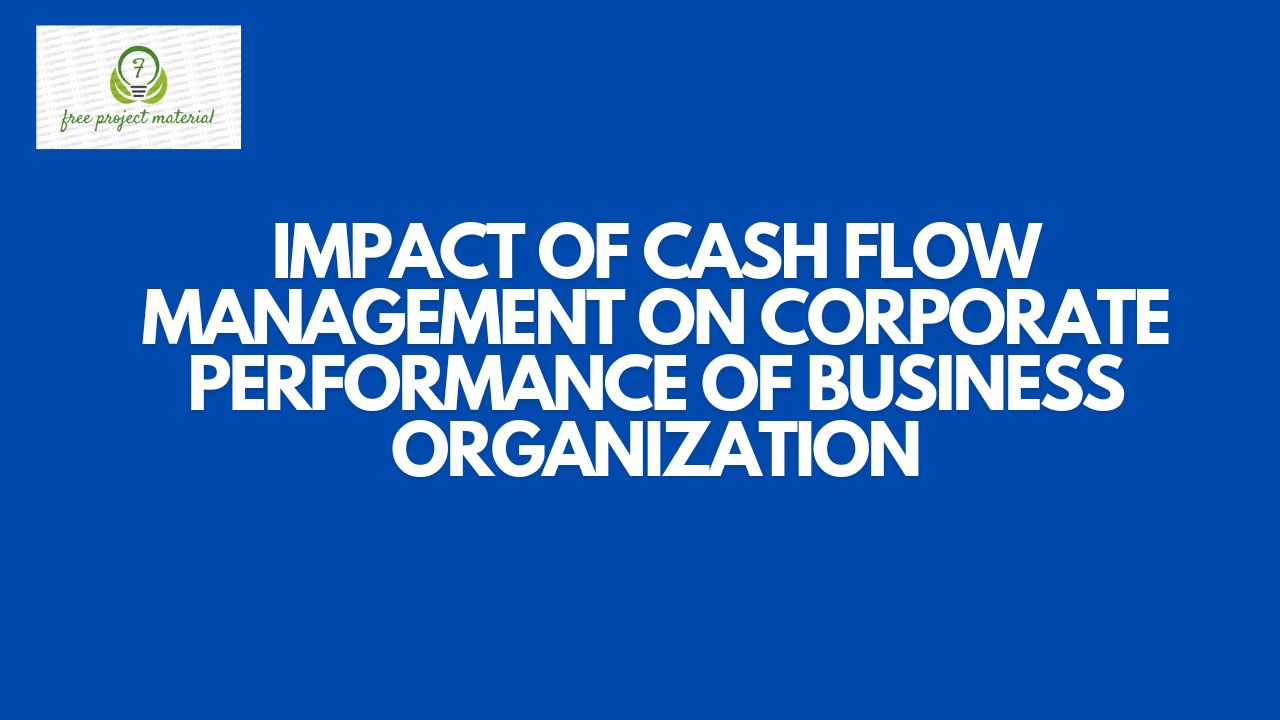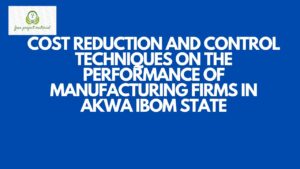ABSTRACT
This study was designed to examine the impact of cash flow management on corporate performance of business organization (A case study of Champion Breweries Plc, Uyo). To accomplish the objectives of the study, the study adopted the survey research design while the Taro Yamane formula was used to select hundred and sixteen (116) respondents as the sample size for the study. Instrument of the study was a self-developed questionnaire and the forms were personally administered. Research questions were formulated to guide the study and data were analyzed using the descriptive statistical tools which involved the use of simple percentages and frequency tables. Based on the data analysis, findings of the study revealed that; There was a significant impact of operating cash flow, investing cash flow and financing cash flow on the corporate performance of business organization. Furthermore, the challenges to effective cash management in business organization includes; not having sufficient reserve, poor financial forecasting and reporting practices and failing to develop a solid pricing strategy. The researcher recommends that corporate business organizations in Nigeria should improve their finance income as finance is critical in just about every business decision, from planning and budgeting and cash flow management to the capital structure and how a firm control risks and costs.
LIST OF TABLES
Table 4.1.1: Responses to Research question one – – – 25
Table 4.1.2: Responses to Research Question Two – – – 26
Table 4.1.3: Responses to Research question Three – – – 27
Table 4.1.4: Responses to Research question four – – – 28
TABLE OF CONTENTS
Title page – – – – – – – – – i
Approval page – – – – – – – – ii
Declaration – – – – – – – – – iii
Certification – – – – – – – – iv
Dedication – – – – – – – – – v
Acknowledgement – – – – – – – vi
Abstract – – – – – – – – – vii
List of Tables – – – – – – – – viii
Table of Contents – – – – – – – – ix
CHAPTER ONE
INTRODUCTION
1.1 Background of the Study – – – – – – 1
1.2 Statement of the Problem – – – – – – 4
1.3 Objective of the study – – – – – – 6
1.4 Research Question – – – – – – – 7
1.5 Scope of the Study – – – – – – – 8
1.6 Significance of the Study – – – – – – 8
1.7 Limitations of the Study – – – – – – 9
1.8 Organization of the Study – – – – – – 9
1.9 Definition of Terms – – – – – – 10
CHAPTER TWO
REVIEW OF RELATED LITERATURE
2.1 Conceptual Framework – – – – – – 11
2.1.1 Cash Flow – – – – – – – – 11
2.1.2 Cashflow Management – – – – – – 12
2.1.3 Corporate Performance – – – – – – 13
2.1.4 Concept of Financial Performance – – – – 14
2.1.5 Operating Cash Flow Activities and Corporate
Financial Performance – – – – – – 15
2.1.6 Investing Cash Flow Activities and Corporate Financial
Performance – – – – – – – – 15
2.1.7 Financing Cash Flow and Corporate Financial
Performance – – – – – – – – 16
2.2 Theoretical Framework – – – – – – 16
2.2.1 Free Cash Flow Theory – – – – – – 16
2.2.2 Pecking Order Theory – – – – – – 17
2.3 Empirical Framework – – – – – – 18
2.4 Gap in Literature – – – – – – – 20
CHAPTER THREE
RESEARCH DESIGN/ METHODOLOGY
3.1 Research Design – – – – – – – 21
3.2 Population of the Study – – – – – – 22
3.3 Sampling Size – – – – – – – 22
3.4 Instrumentation – – – – – – – 23
3.5 Method of Data Analysis – – – – – – 23
3.6 Problems of Data Collection – – – – – – 24
CHAPTER FOUR
DATA PRESENTATION ANALYSIS AND INTERPRETATION
4.1 Analysis of Research Questions – – – – – 25
4.1.1 Analysis of Research Question One – – – – 25
4.1.2 Analysis of Research Question Two – – – – 26
4.1.3 Analysis of Research Question Three – – – 27
4.1.4 Analysis of Research Question Four – – – – 28
4.2 Discussion of Findings – – – – – – 30
CHAPTER FIVE
SUMMARY, CONCLUSION AND RECOMMENDATION
5.1 Summary of Findings – – – – – – 32
5.2 Conclusion – – – – – – – – 32
5.3 Recommendations – – – – – – – 33
References
Appendix I
Appendix II
CHAPTER ONE
INTRODUCTION
1.1 Background of the Study
Cash in organizations usually takes two direction and are – inflow and outflow. The difference between these two concepts results in cash flow (Akinloye, 2013). Thus, a financial manager in an organization makes it a priority to ensure cash outflow does not outweigh the cash inflow. Net positive cash flow connotes there is prudent management of cash under the three activities in the organization, which are – operating, investing and financing activities.
Similarly, Adegbie and Fakile (2018) explain cashflows from operating activities as the cash effects of transactions and other events relating to trading activities, included in the profit and loss in arriving at operating profit. Alternatively, cashflows from investing activities are cash inflows and outflows associated with the purchase and disposal of productive facilities used by the company and investments in the security of other companies, while cashflow from financing activities include inflows and outflows of cash involved in obtaining cash from external sources for the purposes of financing the company and its operations (Adedeji & Oboh, 2017). Examples of investing cash flows are payments to acquire property, plant and equipment, loans by the reporting entity and payments to acquire debt instruments of other entities excluding payments for the acquisition or disposal or a movement in liquid resources. Others are receipts from sales or disposals of property, plant or equipment and receipts from repayment of the reporting entities, loans to other entities or sales of debt instruments of other entities other than receipts forming part of an acquisition or disposal or a movement in liquid resources.
Firms’ efficient cash flow management is significant tool to enhance financial performance. Exercising proper management of cash flow is vital to the persistence of business. Cash flow management is primarily concerned with identifying effective policies that balance customer satisfaction and service costs (Bendavid et al., 2017). Firms manage efficiently of cash flows via working capital by balancing liquidity and profitability. Working capital management, which is the main source of firm cash flow has significant importance, where firms are restricted with limited access to external capital markets. In order to fulfill their cash flow needs firms heavily depend on internal funds, short-term bank loans, and trade credit in order to finance their undertakings (Ding et al., 2013).
Cashflow management is vital to the sustenance of a firm’s liquidity. Organizations require large capital outlay to effectively carry out their operations. A situation where the available capital is not properly managed will be detrimental to the financial health of the company. Proper cash flow management systems in business help the managers to: Control spending with respect to the specified budget, minimize borrowing and maximise the opportunity cost of its company’s resources (Bari et al., 2019).
Financial performance is an essential measure to access the well-being of a company. This measures the ability of the company to utilize its resources efficiently and effectively to achieve the desired result. This assertion is in line with the view of Kenton (2021) sees “financial performance as a subjective measure of how well a firm can use assets from its primary mode of business and generate revenues”. The financial performance of a company can be accessed through various indicators like profitability ratios and liquidity ratios.
Liquidity has for long been discussed and deliberated by management of companies and financial analysis alike. Liquidity is essential to the day to day running of the business as cash (finance) is considered the life wire to an organization. To some analysts, profitability is preferable to liquidity while to others, liquidity is the ultimate thing and should be sought for and maintained.
Business organization’s performance, often measured in terms of financial, market, and shareholder performance is a comprehensive evaluation of how successfully a company achieves its key goals. It also has an interest in the organization’s wellbeing, which is typically gauged by how well it performs financially. The idea of corporate performance has, nevertheless, expanded in recent years. The current consensus is that it also takes into account other aspects, including social responsibility and reputation, innovation, staff morale, and productivity, in addition to financial considerations. As a result, key performance indicators (KPI) like revenue, return on investment (ROI), return on total assets (ROA), and overhead and operational costs are no longer the only metrics used to assess performance.
Therefore, the focus of this study would be to examine the impacts of cash flow management on corporate performance of business organization (a case study of Champion breweries).
1.2 Statement of the Problem
Cash inflows and outflows are the heartbeat of every business endavour. One of the main reasons that businesses fail is their inability to meet their financial obligations when they fall due as they have run out of cash. Knowing how to maintain a healthy cash flow is essential to a successful business. A lack of cash flow data has caused problems for investors and analysts in assessing a company’s performance. This has led to major issues for diverse companies in meeting up with dividends paid, income tax paid and interest paid on their business activities.
The previous studies on the relationship between cashflow and corporate performance include cash flow management and financial performance of quoted oil and gas firms in Nigeria, cash flow management and industrial firms’ performance in Nigeria, a study on the relationship between cash flow and financial performance of insurance companies, cashflow and organizational performance in Nigeria: hospitality and print media industries perspectives and effects of cash flow Management on Financial Performance of Small and medium enterprise in Mogadishu Somalia.
These studies have been carried out in diverse economic sectors employing various business performance, methodology, variable, study site, and time frame criteria. Empirical research frequently produces contradictory findings. These contradictory findings show that the relationship between cash flow and company performance is not fully understood. The study’s focus has expanded to include cash flow and business financial performance because of the ambiguous results.
Therefore, to close the geographic and study site gaps noted in the previous research, this study will examine the impact of cash flow on the corporate performance of business organization using Champion Breweries as the case study.
1.3 Objectives of the Study
The main objective of this study is to determine the impact of cash flow management on corporate performance of business organization (A case study of Champion breweries). The specific objectives are:
- To determine the impact of operating cash flow on the corporate performance of business organization
- To ascertain the impact of investing cash flow on the corporate performance of business organization
- To evaluate the impact of financing cash flow on the corporate performance of business organization
- To determine the strategies for effective management of cash flow in business organization
- To ascertain the challenges to effective cash flow management in business organization
1.4 Research Questions
This study for impact of cash flow management on corporate performance of business organization has the following question to help achieve the stated objective;
- Does operating cash flow impacts on the corporate performance of business organization?
- Does investing cash flow impacts on the corporate performance of business organization?
- Does financing cash flow impacts on the corporate performance of business organization?
- What are the strategies for effective management of cash flow in business organization?
- What are the challenges to effective cash flow management in business organization?
1.5 Scope of the Study
This study on the impact of cash flow management on corporate performance of business organization uses Champion breweries as case study, as such, the study will involve both male and female staff champion breweries Plc Uyo.
1.6 Significance of the Study
The importance of this research cannot be overemphasized as this study can make the management of the firms see the need to improve their profitability. It can be foreseen that this research will provide useful insight to improve corporate performance. The result of the study will assist the management and other stakeholders of the firms.
The outcomes of this study will also help the investors that put their resources into the company, to make a sound investment decision, and the creditors that give the firm loan would be assured to get paid back with interests. To the shareholders, their return on investment would be greatly affected if the organization’s corporate finance performance is low.
This research would also contribute to the existing body of knowledge because it provides additional empirical data on the impact of cash flow on corporate performance in Nigerian business organization. Future researchers can build on this research by conducting similar studies in other developing nations and other economic sectors of Nigeria.
1.7 Limitation of the Study
There is no doubt a study of this nature would have its limitations which are the challenges faced while on the field. Some of the limitations that were encountered among others are time constraints and difficulty associated with the collection of primary data from the case study business organization.
1.8 Organization of the Study
The study is divided into five chapters. Chapter one discusses a general introduction and an overview of the background to the research, statement of problem, research objectives, research questions, significance of the study scope of the study, limitation of the study, and the structure of the research. Chapter two looks at the literature review of the research, the conceptual framework, theoretical framework and empirical framework of the research.
Chapter three focuses on the research methodology in terms of research. Design, population of the study, sampling technique, sample size, instrumentation, method of data Analysis and problems of data collection.
Chapter four focuses on Data presentations, Analysis and interpretation.
Chapter five carries the summary conclusion and recommendation
1.9 Definition of Terms
Cash flow: This is made up of financing cash flow (FINCF), investing cash flow (INVCF), and operating cash flow (OPCF).
Corporate Performance: It is assessed using the term return on total assets (ROA), which is calculated as profits after tax divided by total assets.
Financing Cash Flow: This metric assesses the net cash flow from financing activities.
Investing Cash Flow: This is the net cash flow generated by investing activities.
Operating Cash Flow: This metric assesses the net cash flow from operating activities.
Business Organization: This is an entity formed for the purpose of carrying on commercial enterprise



